|
Definition: An artifact is any object that man has made or manipulated in some way. 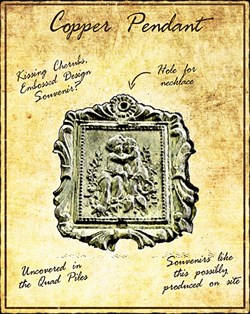
courtesy of Tim Spillane Souvenirs for purchase One such artifact was a copper pendant that featured an embossed scene of two cherubs kissing against a simple floral backdrop. The scene was enframed and at the top was a small hole allowing the pendant to be worn as a necklace. Archaeologists found other items of this kind in the quad piles- like a silver pendant in the shape of a Victorian lady's boot. The presence of raw copper within the quad piles and several crucibles at the site of Stand "P" suggests that the stand operators produced these items on site, and then sold the souvenirs to park visitors. 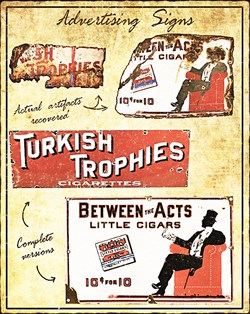
courtesy Tim Spillane Advertising Signs Another artifact type that the archaeologists encountered at Merrie Way were advertising signs. These signs, found at various locations on site, adorned the concession stands and advertised merchandise to park visitors , announcing to park visitors what was being sold. Fortunately, the signs can still be read, even after being buried in the sand for 100 years. Archeologist found the first metal advertisement for a cigarette brand, "Turkish Trophies" among the trash pit contents likely associated with concession Stand "Q". The second metal cigarette sign was for "Between the Acts, Little Cigars." The sign showed a man with a top-hat smoking in a big red chair and offered the product for just a penny a piece. As windows into the past, the advertisement signs inform us about merchandise sold and consumed at Merrie Way, as well as the popular design, styles and habits of the day.
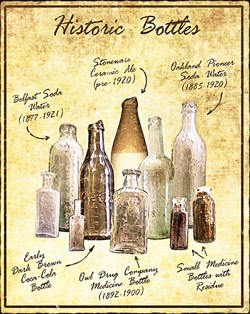
courtesy of Tim Spillane Historic Bottles Historic bottles were prominent among the artifacts found on the archaeological sites. Bottles carry the potential to provide a wealth of information. The materials with which they are produced, the methods of their production, their style, color, marks, and contents all give archaeologists insight into the cultural contexts in which they are found. Even a small fragment of a bottle- if it shows part of an embossed maker's mark or a distinctive color, an effect of a particular form of manufacture or residue from what was in it- even the tiniest shard of information can shed much light. The archaeologists found an enormous number and variety of historic bottles at Merrie Way. They most commonly found soft-drink bottles- soda-water, ginger-ale, and cola, that were manufactured locally in San Francisco and Oakland. The archaeologists found an impressive number of beer and spirits bottles on site; most of them were made of glass, but a few of them were stoneware ceramic. There is no question that beverages of this kind were sold and consumed at Merrie Way throughout its history. Bottles within the archeological inventory have manufacture dates spanning the life of the park. Archeologist also found various medicine bottles scattered in multiple locations and have inferred these medicine bottles are associated with the visitor's domestic and personal life and not related to businesses conducted at the Stands. Though much fewer in number, the medicine bottles rival the beverage bottles in information and aesthic value. 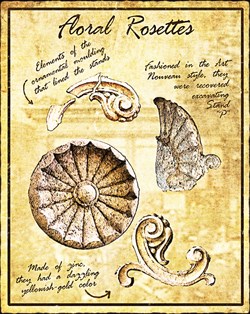
courtesy Tim Spillane Decorative Architectural Moldings Decorative architectural moldings are one of the longest lasting remnants of the Merrie Way concession stands. The archaeologist recovered the molding examples at the burnt foundation of Concession Stand "P". The floral rosette trim had a stately gold color and was fashioned out of zinc. Stand "P" was lined with floral, circular and shell-textured rosette moldings; these artifacts have been added to the GGNRA collections. The Art Nouveau style, with its curls, rosettes and curvilinear shapes, was very popular at the turn of the 20th century. These architectural themes in the Nouveau style were a familiar feature at international expositions since the 1890's, linking Merrie Way this tradition. 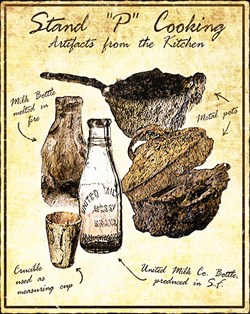
courtesy of Tim Spillane Small Kitchen Utensils Archaeologists found small kitchen utensils from Stand "P", had burnt down on more than one occasion. After the last fire, the stand's contents were in a charred heap on the floor. The archaeologist found several pots and pans smong the remains which were in proximity to a large container filled with metal cans. A large number of milk bottles were piled on the opposite side of the structure, many were warped and melted in the fire. Ceramic crucibles, locally produced by the Justinian Caire Company of San Francisco, were also amidst the rubble. The crucibles had been stamped with their measurement size so archelogists think that the stand operators likely used the crucibles as measuring cups. After analysing historical information, combined with the nature of the cooking implements and the stand's extant food refuse, the archologists think that the ceramic crucibles were used to make candy, which was then at Stand "O".
For More Information:
To learn more about the history of Lands End and visitor information for this area, please visit the Lands End Plan Your Visit page. |
Last updated: February 28, 2015
